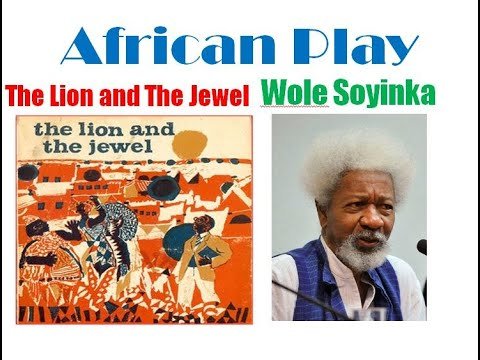Wole Soyinka, Nigeria’s first Nobel laureate in Literature, is one of Africa’s foremost playwrights. His play The Lion and the Jewel was first performed in 1959, making it a crucial piece of African drama. Set in a rural Nigerian village, the play explores the intersection of traditional African values and modern influences, especially as they pertain to the roles of women, leadership, and the clash between traditional customs and colonial influences.
The play is a comedic yet thought-provoking exploration of the struggle between two dominant forces— tradition and modernity. Soyinka’s rich use of humor, symbolism, and cultural reference points makes the play an essential study in the Nigerian literary canon, as well as a commentary on the broader African experience.
Summary
The plot of The Lion and the Jewel revolves around three primary characters: Baroka, the village chief (referred to as “the Lion”); Sidi, the beautiful young woman of the village (the “Jewel”); and Lakunle, the young schoolteacher. The story is set in the fictional village of Ilujinle, in Nigeria.
Lakunle, representing the modernizing forces of Western education, attempts to convince Sidi, the beautiful village belle, to marry him, promising her a life of modern comforts. However, Sidi is drawn to the traditional chief, Baroka, who represents the established way of life in the village. Baroka, despite his age, uses his wit and cunning to woo Sidi, engaging in a clever seduction game that challenges both Lakunle’s ideals and Sidi’s notions of what it means to be empowered.
Key Plot Details
- Lakunle vs. Baroka: The central conflict arises from the rivalry between Lakunle, who seeks to marry Sidi in a modern, progressive manner, and Baroka, who relies on his traditional authority and sexual prowess. The two men offer different lifestyles, with Lakunle advocating for education and modernization, while Baroka appeals to Sidi’s desire for status and comfort.
- Sidi’s Dilemma: Sidi, initially intrigued by Lakunle’s ideas about modernity, finds herself swayed by Baroka’s charm and persuasive tactics. The way the village chief uses both his political power and sexual allure makes her question the values she holds dear.
- The Village Setting: The village of Ilujinle serves as a microcosm of the larger clash between old and new. Its customs, traditions, and the role of women within the society are all integral parts of the story, and the characters’ interactions highlight the deep divides within Nigerian society during the post-colonial era.
- Baroka’s Trickery: The central twist occurs when Baroka outsmarts Lakunle and seduces Sidi, ultimately winning her as his wife. This reveals Soyinka’s commentary on the adaptability of tradition, suggesting that, despite the pressures of modernity, traditional values and ways of life are often resilient and influential.
Settings of the Book
The play is set in a traditional Nigerian village, Ilujinle, that provides a vivid backdrop for the unfolding drama. Soyinka uses the village to symbolize the tension between the rural, traditional life and the encroaching influence of Western modernization. The setting itself is crucial to the themes of the play, as it encapsulates the daily life of the people, their customs, and their beliefs. The stage setting, especially the open-air market and the chief’s palace, acts as a physical representation of the two forces vying for control—modernity and tradition.
Class Activities for The Lion and the Jewel
- Role-Playing Activity: Have students take on the roles of Baroka, Lakunle, and Sidi. Create different scenarios from the play for students to act out, focusing on the moments of conflict, persuasion, and emotional tension. This will help students better understand the characters’ motivations and actions.
- Debate on Modernity vs. Tradition: Organize a classroom debate between two groups: one arguing in favor of modernization and the other defending traditional values. Use characters from the play to support each argument, encouraging students to make connections between the text and the world around them.
- Character Analysis: Assign students to create detailed character sketches of Baroka, Lakunle, and Sidi. They should analyze their actions, motivations, and relationships with other characters, using specific examples from the play to back up their points.
- Historical Context Research: Have students research the history of Nigeria in the 1950s, particularly regarding colonialism and the push for independence. This will help students understand the broader historical context of the play and its themes of modernization.
- Cultural Exploration: Have students explore the traditional Nigerian customs presented in the play, such as the roles of women, the significance of marriage, and the leadership structures in rural communities. Students can present their findings in a short presentation.
Class Assignments for The Lion and the Jewel
- Essay on Themes of Modernity and Tradition: Write an essay analyzing how the play explores the conflict between modernity and tradition. Use examples from the text to illustrate how the characters embody these themes.
- Character Essay: Choose one character (Baroka, Lakunle, or Sidi) and write an essay that explores their personality, their role in the plot, and their significance in conveying the play’s themes.
- Analysis of Setting: Write an essay analyzing how Soyinka uses the setting of Ilujinle to reflect the larger themes of the play. Consider how the setting influences the characters’ behavior and choices.
- Creative Rewrite: Rewrite a scene from the play, changing one of the characters’ decisions or motivations. For example, what if Sidi had chosen Lakunle over Baroka? How would the play’s themes shift?
- Comparative Essay: Compare The Lion and the Jewel with another work by Soyinka or another African playwright. Focus on how both works address issues of identity, culture, and the role of women in society.
Poem Inspired by The Lion and the Jewel by Wole Soyinka
The Lion and the Jewel, a dance of might,
Where tradition and modernity ignite.
In the village of Ilujinle, the stage is set,
With Baroka’s wisdom and Lakunle’s debt.Baroka, the Lion, with strength and charm,
Wields age and cunning as a farmer’s arm.
Sidi, the Jewel, in her beauty’s glow,
Is torn between paths that she does not know.Lakunle, the dreamer, with progress in hand,
Wants to lead her away to a far-off land.
But Sidi is caught in the web of her own,
As Baroka’s traditions echo their tone.The Lion roars, the Jewel is swayed,
The schoolteacher’s words in silence laid.
For in the end, it is not the new or the old,
But the heart’s desire that cannot be sold.So dance, O Lion, with all your pride,
And Jewel, let tradition be your guide.
In this tale of power, charm, and light,
The old and the new clash in the night.
Conclusion
Wole Soyinka’s The Lion and the Jewel remains a powerful exploration of Nigerian culture, offering insight into the tensions between traditional beliefs and the winds of modern change. Its rich characters, themes, and settings provide a compelling study for anyone interested in understanding not only Nigerian society but also the broader African experience. The play’s humor, irony, and critique of both tradition and modernity make it a timeless piece that resonates with audiences even today.

